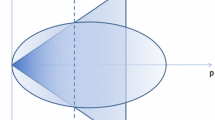Abstract
Cam-Clay nonassociative plasticity exhibits both hardening and softening behaviour, depending on the loading. For many initial data the classical formulation of the quasistatic evolution problem has no smooth solution. We propose here a notion of generalized solution, based on a viscoplastic approximation. To study the limit of the viscoplastic evolutions we rescale time, in such a way that the plastic strain is uniformly Lipschitz with respect to the rescaled time. The limit of these rescaled solutions, as the viscosity parameter tends to zero, is characterized through an energy-dissipation balance, that can be written in a natural way using the rescaled time. As shown in Dal Maso and DeSimone (Math Models Methods Appl Sci 19:1–69, 2009) and Dal Maso and Solombrino (Netw Heterog Media 5:97–132, 2010), the proposed solution may be discontinuous with respect to the original time. Our formulation allows us to compute the amount of viscous dissipation occurring instantaneously at each discontinuity time.
Similar content being viewed by others
References
Boccardo L., Murat F.: Remarques sur l’homogénéisation de certains problèmes quasi-linéaires. Portugal. Math. 41, 535–562 (1982)
Brezis, H.: Opérateurs maximaux monotones et semi-groupes de contractions dans les espaces de Hilbert. North-Holland/American Elsevier, Amsterdam/New York (1973)
Buttazzo G.: Semicontinuity, Relaxation and Integral Representation Problems in the Calculus of Variations. Pitman Research Notes in Mathematics Series. Longman, Harlow (1989)
Dal Maso G., DeSimone A., Mora M.G.: Quasistatic evolution problems for linearly elastic-perfectly plastic materials. Arch. Ration. Mech. Anal. 180, 237–291 (2006)
Dal Maso G., Demyanov A., DeSimone A.: Quasistatic evolution problems for pressure-sensitive plastic materials. Milan J. Math. 75, 117–134 (2007)
Dal Maso G., DeSimone A.: Quasistatic evolution problems for Cam-Clay plasticity: examples of spatially homogeneous solutions. Math. Models Methods Appl. Sci. 19, 1–69 (2009)
Dal Maso G., Solombrino F.: Quasistatic evolution for Cam-Clay plasticity: the spatially homogeneous case. Netw. Heterog. Media 5, 97–132 (2010)
Dal Maso, G., DeSimone, A., Solombrino, F.: Quasistatic evolution for Cam-Clay plasticity: properties of the viscosity solution (in preparation)
Doob J.L.: Stochastic Processes. Wiley, New York (1953)
Duvaut G., Lions J.-L.: Inequalities in Mechanics and Physics. Grundlehren der Mathematischen Wissenschaften, vol. 219. Springer, Berlin (1976)
Efendiev M., Mielke A.: On the rate-independent limit of systems with dry friction and small viscosity. J. Convex Anal. 13, 151–167 (2006)
Ekeland, I., Temam, R.: Convex Analysis and Variational Problems. North-Holland, Amsterdam (1976). Translation of Analyse convexe et problèmes variationnels. Dunod, Paris (1972)
Gagliardo E.: Caratterizzazione delle tracce sulla frontiera relative ad alcune classi di funzioni in n variabili. Rend. Sem. Mat. Univ. Padova 27, 284–305 (1957)
Goffman C., Serrin J.: Sublinear functions of measures and variational integrals. Duke Math. J. 31, 159–178 (1964)
Hahn H.: Über Annäherung an Lebesgue’sche Integrale durch Riemann’sche Summen. Sitzungsber. Math. Phys. Kl. K. Akad. Wiss. Wien 123, 713–743 (1914)
Henstock R.: A Riemann-type integral of Lebesgue power. Can. J. Math. 20, 79–87 (1968)
Hughes T.J.R., Taylor R.: Unconditionally stable algorithms for quasi-static elasto-viscoplastic finite element analysis. Comput. Struct. 8, 169–173 (1978)
Matthies, H., Strang, G., Christiansen, E.: The saddle point of a differential program. In: Glowinski, R., Rodin, E., Zienkiewicz, O.C. (eds.) Energy Methods in Finite Element Analysis, pp. 309–318. Wiley, New York (1979)
Mawhin, J.: Analyse. Fondements, techniques, évolution. Second edn. Accès Sciences. De Boeck Université, Brussels (1997)
Mielke A., Rossi R., Savaré G.: Modeling solutions with jumps for rate-independent systems on metric spaces. Discret. Cont. Dyn. Syst. 25, 585–615 (2009)
Mielke, A., Rossi, R., Savaré, G.: BV-solutions of the viscosity approximation of rate-independent systems. WIAS Preprint, Berlin (2009)
Moreau, J.J.: Champs et distributiond de tenseurs déformation sur un ouvert de connexité quelconque. Séminaire d’analyse convexe, vol. 6. Université de Montpellier, Montpellier (1976)
Ortiz, M.: Topics in constitutive theory for inelastic solids. PhD thesis, University of California, Berkeley (1981)
Perzyna P.: Thermodynamic theory of viscoplasticity. Adv. Appl. Mech. 11, 313–354 (1971)
Phillips R.B.: Crystals, Defects and Microstructures. Modeling Across Scales. Cambridge University Press, Cambridge (2001)
Reshetnyak Y.G.: Weak convergence of completely additive vector functions on a set. Sib. Math. J. 9, 1039–1045 (1968)
Rockafellar R.T.: Convex Analysis. Princeton University Press, Princeton (1970)
Rossi, R.: Interazione di norme L 2 e L 1 in evoluzioni rate-independent. Lecture given at the “XIX Convegno Nazionale di Calcolo delle Variazioni”, Levico (Trento), February 8–13, 2009
Rudin W.: Real and Complex Analysis. McGraw-Hill, New York (1966)
Saks S.: Sur les fonctions d’intervalle. Fundam. Math. 10, 211–224 (1927)
Solombrino F.: Quasistatic evolution problems for nonhomogeneous elastic-plastic materials. J. Convex Anal. 16, 89–119 (2009)
Stein E.M.: Singular Integrals and Differentiability Properties of Functions. Princeton University Press, Princeton (1970)
Suquet P.: Sur les équations de la plasticité: existence et regularité des solutions. J. Mécanique 20, 3–39 (1981)
Temam R.: Mathematical Problems in Plasticity. Gauthier-Villars, Paris (1985). Translation of Problèmes mathématiques en plasticité. Gauthier-Villars, Paris (1983)
Temam R., Strang G.: Duality and relaxation in the variational problem of plasticity. J. Mécanique 19, 493–527 (1980)
Truskinovsky, L.: Quasi-static deformation of a system with nonconvex energy from a perspective of dynamics. Lecture given at the workshop “Variational Problems in Materials Science”, SISSA, Trieste, September 6–10, 2004
Author information
Authors and Affiliations
Corresponding author
Additional information
Communicated by L. Ambrosio.
Rights and permissions
About this article
Cite this article
Dal Maso, G., DeSimone, A. & Solombrino, F. Quasistatic evolution for Cam-Clay plasticity: a weak formulation via viscoplastic regularization and time rescaling. Calc. Var. 40, 125–181 (2011). https://doi.org/10.1007/s00526-010-0336-0
Received:
Accepted:
Published:
Issue Date:
DOI: https://doi.org/10.1007/s00526-010-0336-0




